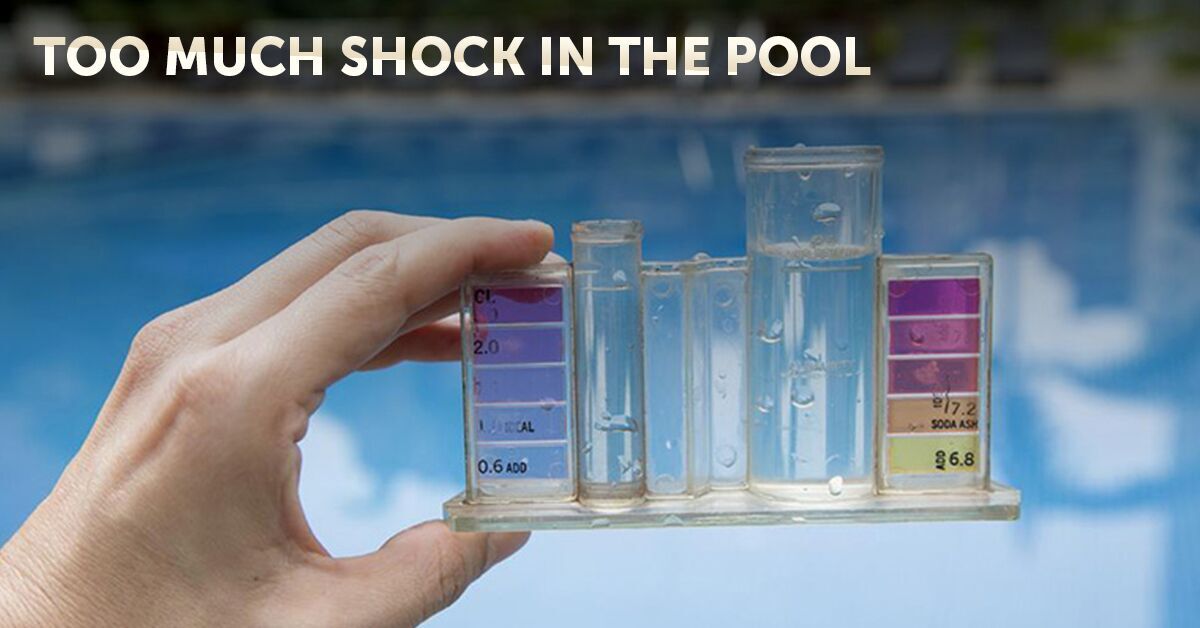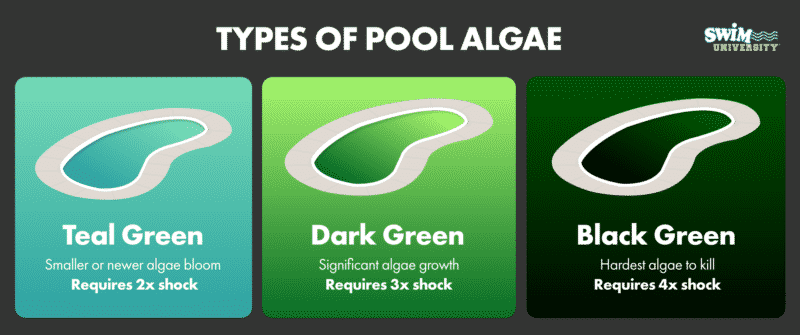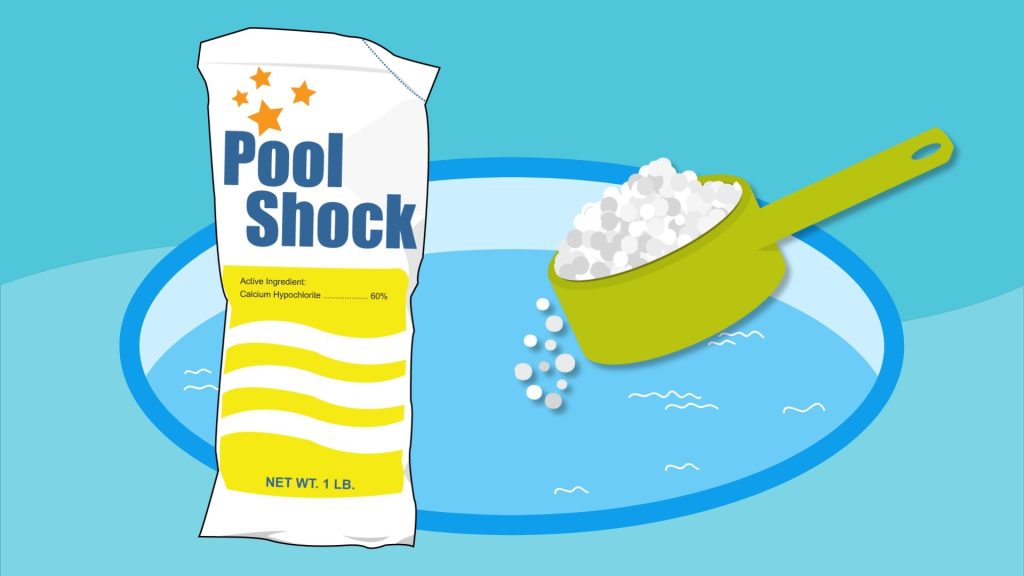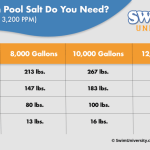To determine how much shock to add to your pool, calculate the correct dosage based on the pool’s volume and current water condition. This will ensure effective sanitation and maintenance.

Credit: www.inyopools.com
Importance Of Pool Shocking
Regularly shocking your pool is a crucial aspect of pool maintenance. Pool shocking involves adding a concentrated amount of chlorine to the pool water to kill off bacteria and other harmful contaminants that may have built up over time. This process helps in maintaining clean and crystal-clear water, ensuring a safe and enjoyable swimming environment for you and your family.
Benefits Of Regular Pool Shocking
- Preventing the growth of algae and bacteria
- Boosting overall water clarity and quality
- Extending the lifespan of pool equipment
Consequences Of Not Shocking Your Pool
- Increased risk of algae and bacteria buildup
- Potential health hazards for swimmers
- Deterioration of pool surfaces and equipment
Determining The Right Amount Of Shock
Determining the right amount of shock for your pool is crucial for maintaining water clarity and safety. Find the perfect balance by considering pool size, water condition, and manufacturer instructions. With proper calculation and testing, you can ensure optimal sanitizer levels and a refreshing swimming experience.
Factors To Consider
The correct amount of shock to add to a pool is crucial for maintaining safe and clean water. Determining the right amount of shock hinges on several factors that need to be taken into account:
- Current pool water condition
- Weather conditions and pool usage
- Type of shock being used
Calculating Pool Size And Shock Dosage
For accurate shock dosing, it’s important to calculate your pool’s size and the appropriate shock dosage. Use the following formula to calculate the amount of shock to add:
| Pool Size (in gallons) | Amount of Shock (in pounds) |
|---|---|
| Less than 10,000 | 1 pound |
| 10,000 – 20,000 | 2 pounds |
| 20,000 – 30,000 | 3 pounds |
| 30,000 – 40,000 | 4 pounds |
| 40,000 – 50,000 | 5 pounds |
Types Of Pool Shock
For accurate pool shock dosing, analyze pool size, and water conditions. Always follow product instructions meticulously for optimal results.
Chlorine Shock
Chlorine shock is a popular choice for pools as it effectively combats bacteria and algae.
- Quick dissolving granules
- Concentrated chlorine content
- Effective sanitation and oxidation
Regular use can maintain a clean and safe swimming environment for everyone.
Non-chlorine Shock Options
Non-chlorine shock provides an alternative for those sensitive to chlorine or looking for gentler treatment options.
- Oxygen-based shock
- Potassium shock
- Monopersulfate shock
These options deliver powerful oxidation without the harsh effects of chlorine, suitable for various pool types.

Credit: www.swimuniversity.com
When To Shock Your Pool
Regularly shocking your pool is an essential part of pool maintenance, ensuring that it stays clean, clear, and safe for swimming. But how do you know when it’s time to shock your pool? In this section, we’ll guide you through the regular shocking schedule and the signs that indicate your pool needs shocking.
Regular Shocking Schedule
Establishing a regular shocking schedule is crucial to maintaining a healthy pool. The frequency of pool shocking depends on various factors, such as pool usage, weather conditions, and water chemistry.
Here’s a general guideline for a regular pool shocking schedule:
- Weekly: Shock your pool every week to prevent the buildup of contaminants and maintain proper water quality.
- After Heavy Pool Usage: If your pool has experienced heavy usage, such as a pool party or a large gathering, it’s important to shock it afterwards to eliminate any potential bacteria or algae growth.
- After Rain or Storms: Rainfall can introduce contaminants into your pool, so it’s crucial to shock your pool after heavy rain or storms.
- Water Chemistry Imbalance: If you notice a significant change in your pool’s water chemistry, such as high chlorine demand or cloudy water, it’s advisable to shock your pool to restore proper water balance.
Establishing a regular shocking schedule not only helps to maintain a clean and safe swimming environment, but it also prevents the need for more extensive and expensive pool treatments down the line.
Signs That Your Pool Needs Shocking
While following a regular shocking schedule is important, there are also specific signs that indicate your pool needs an immediate shock treatment. These signs include:
- Strong Chlorine Odor: If your pool water has a strong chlorine odor, it’s a clear indication that there’s an excess of chloramines, which are formed when chlorine interacts with contaminants. Shocking the pool will break down the chloramines and restore a fresh and clean smell.
- Algae Growth: The presence of algae in your pool water is a clear sign that your pool needs shocking. Algae growth can quickly transform your pool into an uninviting and unsafe environment. Shocking the pool will eliminate the algae and prevent further growth.
- Cloudy or Discolored Water: If your pool water appears cloudy, hazy, or discolored, it indicates the presence of particles and contaminants. Shocking the pool will help to clear the water and restore its sparkle.
- Bather Discomfort: If swimmers complain of itching, red eyes, or skin irritation after pool use, it’s likely that your pool water lacks proper sanitization. Shocking the pool will address this issue and provide a more comfortable swimming experience.
By being mindful of these signs, you can ensure that your pool remains in top condition and ready for fun and relaxation whenever you want.
How To Add Shock To Your Pool
Precautions Before Adding Shock
1. Test the Water: Use a pool testing kit to check the current chemical levels.
2. Wear Protective Gear: Safety goggles and gloves are essential when handling pool shock.
3. Keep Children and Pets Away: Ensure the area is clear before adding shock to the pool.
Step-by-step Guide To Adding Shock
- Calculate the Amount: Refer to the manufacturer’s instructions for the correct dosage.
- Dissolve the Shock: Fill a bucket with water and slowly add the shock while stirring.
- Disperse in the Pool: Pour the dissolved shock evenly around the perimeter of the pool.
- Wait Before Swimming: Allow the shock to circulate for a few hours before swimming.
Dealing With Common Pool Shocking Issues
Ensure you calculate the right amount of shock to add to your pool by considering the pool’s water volume and the shock product’s instructions. Use a reliable pool water testing kit before shock treatment and follow the manufacturer’s guidelines to achieve optimal results.
When it comes to maintaining a clean and clear pool, shock treatment plays a vital role. It helps eliminate bacteria, algae, and other contaminants that can cause cloudy water, stains, or residue. However, even with proper pool shocking techniques, you may still encounter some common issues. Understanding how to deal with these problems effectively is crucial to keeping your pool water pristine. In this article, we will explore two common pool shocking issues and provide simple solutions to address them.
Cloudy Water After Shocking
One of the most frustrating problems pool owners face after shocking their pool is cloudy water. Instead of the crystal-clear water you were expecting, your pool may appear hazy and uninviting. So, what causes this cloudiness after shocking, and how can you rectify it?
In most cases, cloudy water after shocking is due to inadequate filtration or insufficient mixing of the shock treatment. When the shock chemicals are not properly dispersed throughout the water, they can create small particles that make the pool water cloudy.
To combat this issue, follow these simple steps:
- Ensure that your pool filter is clean and functioning optimally. Clean or backwash the filter to remove any debris or sediment that may be hindering the filtration process.
- Before adding shock treatment, brush the pool walls and floor to dislodge any algae or bacteria that may be clinging to surfaces. This will help the shock treatment penetrate and kill any remaining contaminants.
- Dissolve the shock treatment in a bucket of water according to the manufacturer’s instructions. This helps ensure that the shock chemicals are well-mixed and can be evenly distributed throughout the pool.
- Pour the dissolved shock treatment along the perimeter of the pool while walking around slowly. This will help disperse the shock chemicals evenly and minimize any clouding that may occur. Avoid pouring the shock directly onto surfaces or in one concentrated area.
- Run the pool filter for at least 8-10 hours a day to ensure proper circulation and filtration of the water. This will help remove any small particles and restore clarity to your pool.
By following these steps and allowing the filter to do its job, you should see a significant improvement in your pool water’s clarity. If the cloudiness persists, consider testing the water chemistry and adjusting the pH and alkalinity levels as needed.
Stains Or Residue After Shocking
Another common issue that pool owners may encounter after shock treatment is the appearance of stains or residue on the pool surfaces. While shock treatment is meant to eliminate contaminants, it can sometimes result in unsightly stains or residue. Here’s what you can do to address this problem:
- Before shocking the pool, test the water for any metals, such as iron or copper. High metal levels can contribute to staining or residue formation. Use a metal sequestrant if necessary to prevent these issues.
- Ensure that the pool water is balanced, with proper pH, alkalinity, and calcium levels. Imbalances in these levels can promote staining or residue formation.
- If you notice stains or residue after shock treatment, use a pool brush and scrub the affected areas gently. This can help loosen and remove the stains or residue from the surfaces.
- Consider using a specialized pool stain remover or metal stain treatment to target specific stains or residue that may be resistant to regular cleaning methods.
Remember to follow the product instructions carefully when using stain removers or metal stain treatments. If the stains or residue persist, it is advisable to seek professional assistance to ensure proper diagnosis and treatment.
Alternative Pool Shocking Methods
When it comes to maintaining a clean and healthy pool, shock treatment is an essential part of the process. However, alternative pool shocking methods can offer effective and convenient options for pool owners who are looking to keep their pools sanitized without traditional chlorine shock treatments.
Saltwater Systems
Saltwater systems provide an alternative to the traditional pool shock method by using a process called electrolysis to generate chlorine from salt. The saltwater generates a continuous supply of chlorine, ensuring that there is always a sufficient amount of sanitizer present in the water. This method eliminates the need for manual shock treatments and can result in softer, silkier feeling water.
Uv Pool Systems
UV pool systems offer another alternative to conventional pool shocking methods. By using ultraviolet light to destroy bacteria, viruses, and algae, UV pool systems provide a method of purifying pool water without the use of chemical shock treatments. This method is effective in reducing chlorine consumption and can help to alleviate the potential for chlorine-resistant bacteria to develop in the pool.
Maintaining Pool Chemistry After Shocking
After shocking your pool, it is crucial to maintain the pool chemistry to ensure a safe and enjoyable swimming experience. Maintaining Pool Chemistry After Shocking involves testing the pool water, balancing pool chemicals, and following proper procedures to keep the water clean and inviting.
Testing Pool Water
Regularly testing pool water is essential to ensure that the chemical levels are balanced. Use testing kits to measure the pH, chlorine, alkalinity, and calcium hardness levels. By doing so, you can identify any imbalances and take necessary actions to restore the water’s chemistry.
Balancing Pool Chemicals
Once the pool is shocked, it is imperative to balance the pool chemicals to maintain optimal water quality. Balancing Pool Chemicals involves adjusting the pH levels, adding stabilizers, and ensuring proper chlorination. Keeping these chemical levels in check preserves the water’s clarity and prevents the growth of algae and harmful bacteria.

Credit: www.youtube.com
Conclusion
Maintaining proper shock levels is crucial for a clean and safe pool environment. By following the recommended dosage guidelines, you can ensure effective water treatment. Remember, balance is key when it comes to pool maintenance. Regularly testing and adjusting shock levels will keep your pool sparkling and ready for enjoyment.





